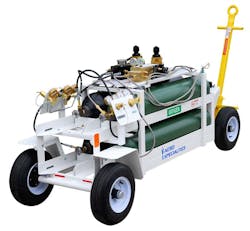Recalibration Guidelines: Aircraft Oxygen And Nitrogen Service Cart Gauges
Questions often arise regarding gauge calibration regulations when servicing aircraft oxygen and nitrogen systems.
The Federal Aviation Administration regularly conducts aircraft support equipment inspections and may impose monetary fines for using equipment with expired calibration certificates. Equipment that does not meet FAA guidelines can also be removed from service at the discretion of the FAA.
It often surprises customers, however, that there is not an exact timetable or calibration cycle dates specified by the FAA for recalibration of oxygen and nitrogen service systems and their oxygen/nitrogen regulators and booster (intensifier) systems.
Most common industry and military standards determine the typical gauge calibration life cycle to be 6 to 12 months.
The objective of gauge recalibration is to minimize out-of-tolerance conditions to an acceptable level. Consensus or organizational standards may be established at operations where no national standards exist. If no consensus standards have been established, the original equipment manufacturer (OEM) standards should be used.
ESTABLISH STANDARD
The proper way to establish the correct gauge recalibration frequency standard is to either examine the literature from the original equipment manufacturer to determine the stability of the gauge(s) and/or adhere to the standards set forth by your organization. Ultimately it is the responsibility of the end user of the oxygen & nitrogen systems (or any aircraft servicing equipment) to determine the appropriate calibration interval under the requirements of its own quality management system.
Obviously, the potential issues that can arise from operating equipment that is past its recalibration due date can be costly – through damage to the aircraft, danger to personnel (during tire servicing, for example) or via the removal, “red tag” or quarantine of service equipment.
Pressure gauges 12 months or older can be prone to experiencing out of tolerance conditions. Gauge degradation is inevitable over the lifetime of any gas pressure measuring instrument and gauge accuracy is properly ensured through periodic professional calibration. The cost of such recalibration is relatively inexpensive, but can often surpass the total cost of purchasing new calibration certified gauges (labor costs, shipping costs, and equipment downtime add up in the long run). For this reason, most customers choose to purchase new gauges in lieu of recalibration.
As always, we are more than willing to assist or answer any questions. We provide new gauges and calibration services for customers on a daily basis
About the author: Derek Rose is director and vice president, sales and marketing for AERO Specialties, a company that has supplied aircraft GSE for 25-plus years to aviation markets throughout the world to more than 11,000 customers.
Pilot John GSE Releases Aircraft Guide App For iPhone Or iPad
Pilot John GSE releases a new go-to reference guide app for the iPhone or iPad. The new app allows anyone to quickly and easily look-up compatible equipment by aircraft from a range of manufacturers.
The app allows customers to view new and used equipment for ground power units (GPUs), electric tugs, hydraulic power units (HPUs), towbars and towbar heads, lavatory and water carts, maintenance tooling, and much more.
Other features include the ability to conduct the following:
- Save aircraft to your favorites list and quickly reference new and used equipment options that are compatible with your fleet.
- Search by part number and see live suggestions of similar and functionally equivalent items in stock.
- Request express quotes quickly on any item just by sliding it to the left and pressing "Quote."
- View your past and present orders, along with current quotes.
- Sell used ground support equipment easily by submitting a purchase request with photos right from the app.
Pilot John GSE provides GSE solutions to corporate flight departments, airlines, military, general aviation and FBOs. It stocks and distributes used, new and refurbished ground service equipment from its North Carolina base to locations throughout the world.
To download or learn more about the app, please visit: https://pilotjohn.com/app or go the Apple Store and search for "Pilot John GSE."
